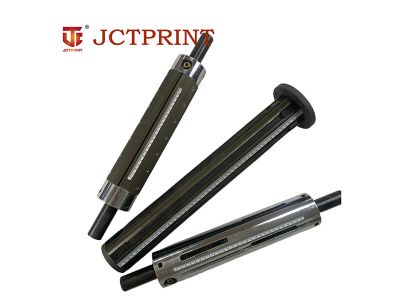Jctprint Machinery Co., Ltd

In the printing and packaging industries, air shafts play a crucial role in the handling of rolls during winding and unwinding processes. Two common types of air shafts used in these processes are Lug Type Air Shafts and Full Lug Air Shafts. Both are designed to grip and secure the core of a roll, but their design and performance characteristics vary significantly. In this article, we’ll break down the key differences between these two types of air shafts and explore their respective advantages, making it easier for you to choose the right one for your specific needs.
Lug Type Air Shafts use multiple independent metal lugs (or keys) along the length of the shaft. These lugs expand outward when air pressure is applied, gripping the core of the roll securely. The lugs are spaced out along the shaft, creating a powerful and concentrated force at specific points along the roll’s core.
Full Lug Air Shafts, also known as continuous lug shafts, feature a uniform expansion mechanism that runs the entire length of the shaft. Instead of individual lugs, the shaft’s surface expands evenly when air pressure is applied, providing a more evenly distributed grip across the entire core of the roll.
| Feature | Lug Type Air Shaft | Full Lug Air Shaft |
|---|---|---|
| Grip Style | Multiple independent metal lugs or keys | Continuous expansion along the entire shaft |
| Force Distribution | Concentrated, localized pressure | Evenly distributed pressure |
| Ideal Use | Heavy rolls, large-diameter cores, high-speed lines | Lighter rolls, delicate cores, and medium loads |
| Risk of Core Damage | Higher (especially for soft or fragile cores) | Lower (due to even pressure distribution) |
| Durability for High Loads | Excellent for heavy-duty operations | Better for lighter to medium-weight applications |
Choose a Lug Type Air Shaft if you’re handling heavy rolls, such as thick films or large rolls of paper, especially in high-speed production environments. The strong, concentrated grip ensures stability even at high speeds.
Choose a Full Lug Air Shaft if you are working with lighter materials or more delicate rolls, where preserving the integrity of the core is essential. This type of air shaft ensures that the pressure is spread evenly, reducing the risk of damaging the core.
Below are images illustrating the differences between the two types of air shafts:
This image shows a Lug Type Air Shaft in use, where individual lugs expand to grip the core of the roll. Notice the concentrated grip points, which make this type highly effective for heavy-duty applications.
This image illustrates a Full Lug Air Shaft where the entire shaft expands evenly, providing uniform pressure along the core. This type is ideal for more delicate rolls or softer core materials.
Both Lug Type Air Shafts and Full Lug Air Shafts serve critical roles in handling rolls during winding and unwinding processes. The choice between these two types comes down to the specific needs of your production line. If you prioritize strong, secure gripping for heavy rolls, the Lug Type Air Shaft is the better option. However, if you're dealing with lighter or more fragile materials, the Full Lug Air Shaft offers a gentler, more even grip.
By understanding the key differences between these air shafts, you can make a more informed decision that will optimize your production process and protect your materials from damage.